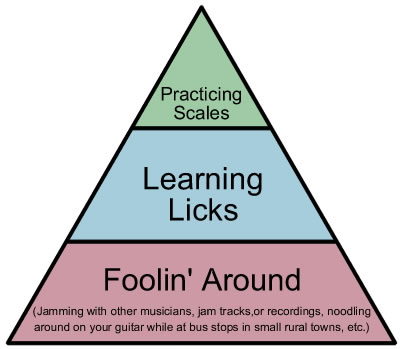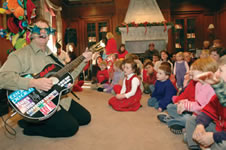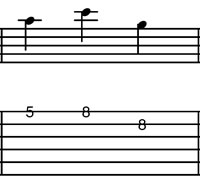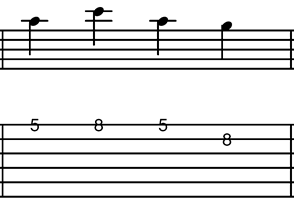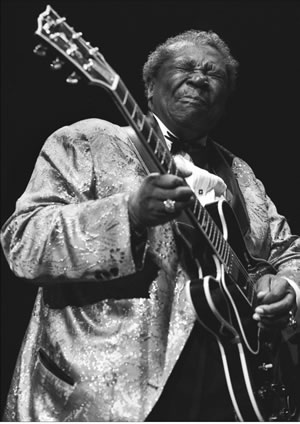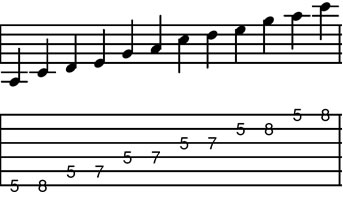
“Hey Zeus, check out this cool riff I learned!”
A couple days ago a blog visitor was telling me how much she was enjoying learning “Wish You Were Here” by Pink Floyd, and asked me if there were some similar songs I could recommend.
“Wish You Were Here” is such a great song for beginning and intermediate guitar players. Usually, gorgeous guitar songs are out of a beginner’s reach–my private students will often ask me to teach them a song by a virtuoso like Jimi Hendrix, John Mayer, Suzanne Vega, or James Taylor, and I have to either simplify the song until it’s barely recognizable, or tell the student to wait (which throws my little teacher’s heart into spasms).
But every once in a while, the guitar gods hand us a gift–a song that’s both beautiful and easy to play.
Here’s a list of Gifts From the Guitar Gods, starting with the easiest songs I know for total beginners, and ending with some divine intermediate songs for mortal fingers. Most titles are linked to chord charts I’ve written for my students. For the songs that involve more than simple strumming, I recommend doing an internet search for tabs or Guitar Pro files.
Gifts for Total Beginners
These are the most common songs and riffs I use in the first few lessons with my beginner students.
For What it’s Worth – Buffalo Springfield – No one knows the name of this song, but most adults recognize it by ear. It can be played with just two chords (E and A) if you simplify the chorus. It’s the easiest guitar song I know, and it sounds great when I play the electric guitar riff over it. Use the folk strum.
Eleanor Rigby – Beatles – My guitar arrangement of this song has just two chords during the verses (Em and C), and a very cool-sounding voice leading part in the chorus (Em7, Em6, C, Em). I teach it using the folk strum or 8th note downstrums. With really young kids–5 through 8 years old–I mute the three bass strings with a piece of felt. Then they can play the whole song using just one finger on the second string: 3rd fret for Em7, 2nd for Em6, 1st for C, and open for Em. When I play along to fill in the bass notes, it sounds great.
Good Riddance – Green Day – Most of my younger students are into the pop-punk bands like Blink 182, Bowling for Soup, Sum 41, All American Rejects, Good Charlotte, and of course, Green Day. Unfortunately, most require power chords, which are easy to play after a few months of practice, but what do you do in the mean time? Most easy songs sound like Mary Had a Little Lamb to these kids’ ears. Thank goodness for Good Riddance–a four-chord acoustic song that, when slowed down and strummed using the folk strum, is easy but still rocks
Smoke on the Water – Deep Purple – Young students are often best introduced to the guitar with single-note riffs or licks instead of chords. The Smoke on the Water riff, played in “E” on the 6th string, is super-easy and sounds cool. If students want to learn the whole song, I re-tune them to drop-D and have them play power chords on the 6th and 5th strings.
The First Cut is the Deepest – Sheryl Crow – Just four easy chords. Listen to little Helena Klein, just 7 years old at the time this was filmed, sing this at my first-ever Jam.
Be Here to Love Me – Norah Jones – Not a very well-known song, but if you love Norah, you’ll love this one. Four easy chords.
Come as You Are – Nirvana – If you strum this song in Em (using, you guessed it, the folk strum pattern), it’s just four easy chords. Another favorite first song for beginning rockers.
Wasting Time – Jack Johnson – A simple bass-strum song by a pro-surfer-turned-moviemaker-turned-musician. It’s nice and slow but my students always rush it. I’ve found that imagining you’re sitting under a palm tree on Maui helps to keep the tempo down.
Gifts for Intermediate Players
Wish You Were Here – Pink Floyd – The intro to this song is made easier by a technique used in many sounds-hard-but-isn’t songs. The third and fourth fingers are parked on the second and first strings, third fret, creating a G chord if you strum the 1st through 4th strings. The first and second fingers cruise around the bass strings, changing the bass notes from G to A to C to B, to create different variations on the G chord. I call these songs G-whiz songs, as in, “G-whiz, I can actually play this!”
I now offer an in-depth song lesson on how to play Wish You Were Here. But it as a one-off, or become a member to access all my premium lessons.
Closer to Fine – Indigo Girls – Another G-whiz song, and a campfire favorite.
Elderly Woman Behind the Counter in a Small Town – Pearl Jam – Yet another G-whiz song. Easier to play than it is to say!
All I Want is You – U2 – G-whiz, another one?! You could spend your whole career playing guitar in the key of G and never get bored….
Boulevard of Broken Dreams – Green Day – Once my Green-Day-obsessed students learn Good Riddance, they often graduate to this song. All the chords are easy except for the B chord, which I have them play as a power chord at the 7th fret, 6th and 5th strings. They usually have to slow down for that one chord, but it’s a small price to pay for being able to rock like Billy Joe Armstrong!
Building a Mystery (live acoustic version) – Sarah McLachlan – The guitar part is kind of complicated, with little embellishments at every turn, but they’re all nice and ergonomic–no big stretches or difficult picking.
Cannonball – Damien Rice – One of my recent discoveries, Cannonball is a great two-guitar song, with a G-whiz rhythm guitar part and an easy-but-hard-sounding lead riff.
Over the Hills and Far Away – Led Zeppelin – This is a challenging song for a beginning or intermediate guitarist–it’s fast and furious the whole way through–but Jimmy Page divides the work between the left and right hands through liberal use of hammer-ons and pull-offs. I learned this song in high school, and got by for the next ten years having terrible right hand technique–I just hammered-on and pulled-off every note that was too fast to pick. Just think of what you can do if you learn this song AND practice scales every once in a while!
Stairway to Heaven – Led Zeppelin – I’ll never forget my buddy Paul McCann telling me “You gotta hear this song by this band Led Zeppelin! It’s like eight minutes long and it starts off all slow and then it starts rockin’ and I think it’s about suicide!” Since then, I’ve heard Stairway to Heaven approximately 7 gazillion times, and I still like playing it. The intro/verse progression is lovely, and it’s easy to fret and pick.
I hope you have fun with these Gifts From the Guitar Gods. What’s that? You were hoping for a ’58 Gibson Les Paul? Sheesh….

 Welcome to Chef Hampton’s All-You-Can-Stand Improvisational Guitar Buffet. Our first course is boiled spinich–a bland, soggy scale exercise that is nonetheless packed with vitamins and minerals. Fortified with clear diagrams and video clips, this meal is an important part of a beginning guitarist’s diet. Bon Appetit!
Welcome to Chef Hampton’s All-You-Can-Stand Improvisational Guitar Buffet. Our first course is boiled spinich–a bland, soggy scale exercise that is nonetheless packed with vitamins and minerals. Fortified with clear diagrams and video clips, this meal is an important part of a beginning guitarist’s diet. Bon Appetit!